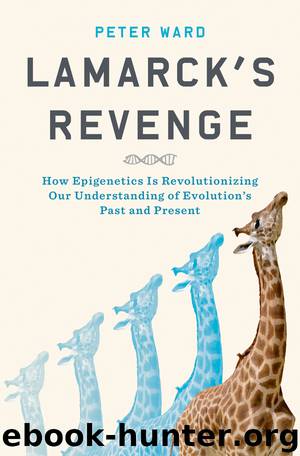Lamarck's Revenge by Peter Ward

Author:Peter Ward
Language: eng
Format: epub
Publisher: Bloomsbury Publishing
CHAPTER IX
The Best and Worst of Times in Human History
Our species is one of the newest in the history of life. Our existence is not measured in millions of years, or even half millions. A fascinating experience would be to somehow bring a member of the very first Homo sapiens back to life to compare to us now. The closest we can come is by comparing skeletons, but we cannot know many of the details of the genome of our most ancient members because there is no DNA from human bones of the first of our species. Compared to other mammals, we are young. Although hominids—the group we belong to—are not.
Paleoanthropologists have done a remarkable job in deciphering the where and when of the speciation event that produced humans.1 The human family, called the Hominidae, seems to have begun as many as 3 million to 4 million years ago with the appearance of a small protohuman called Australopithecus afarensis. Since then, our family has had as many as nine species, although there is ongoing debate about this number as new discoveries are made and new interpretations of past bones make their way into print. But the most important descendant of the early, pre-Pleistocene hominids is the first member of our genus, Homo, a species named Homo habilis (“handyman”) for its ability to use tools. It lived about 2.5 million years ago and gave rise to Homo erectus about 1.5 million years ago, and H. erectus either gave rise to our species, Homo sapiens, directly about 200,000 years ago, or through an evolutionary intermediate known as Homo heidelbergensis. Our species has been further subdivided into a number of separate varieties by some, but as coexisting with other members of the genus Homo, including Homo neanderthalensis, and a poorly studied group known as Denisovans.2
Each formation of new human species occurred when a small group of hominids somehow became separated from a larger population for many generations. In the 1960s and ’70s, there was a view that modern humans came about from what has been called a “candelabra” pattern of evolution3—that all over the planet, separate stocks of archaic hominids such as H. erectus all evolved into H. sapiens at different times and places. This notion has been debunked. The major evolutionary changes leading to the humans of today began among some small, isolated group of humans.
Few topics are more relevant to understanding how humans have arrived in the present day than those that look for major changes in human biology as well as cultural history. Historians of human history essentially divide into three camps. The first group studies past humanity and its cultures from the point of view of fossils, the second uses archeological techniques (excavation of artifacts), and the third studies any kind of written texts or oral histories. The history that is now taught is a combination of these.
Virtually unstudied, however, is whether major environmental changes in human history caused concomitant evolutionary changes not just in morphology and physiology but in heritable human behavior.
Download
This site does not store any files on its server. We only index and link to content provided by other sites. Please contact the content providers to delete copyright contents if any and email us, we'll remove relevant links or contents immediately.
Sapiens: A Brief History of Humankind by Yuval Noah Harari(14212)
Sapiens by Yuval Noah Harari(5281)
Pale Blue Dot by Carl Sagan(4886)
Homo Deus: A Brief History of Tomorrow by Yuval Noah Harari(4801)
Livewired by David Eagleman(3663)
Origin Story: A Big History of Everything by David Christian(3631)
Brief Answers to the Big Questions by Stephen Hawking(3357)
Inferior by Angela Saini(3260)
Origin Story by David Christian(3132)
Signature in the Cell: DNA and the Evidence for Intelligent Design by Stephen C. Meyer(3055)
The Gene: An Intimate History by Siddhartha Mukherjee(3029)
The Evolution of Beauty by Richard O. Prum(2925)
Aliens by Jim Al-Khalili(2776)
How The Mind Works by Steven Pinker(2714)
A Short History of Nearly Everything by Bryson Bill(2616)
Sex at Dawn: The Prehistoric Origins of Modern Sexuality by Ryan Christopher(2472)
From Bacteria to Bach and Back by Daniel C. Dennett(2432)
Endless Forms Most Beautiful by Sean B. Carroll(2414)
Who We Are and How We Got Here by David Reich(2385)
